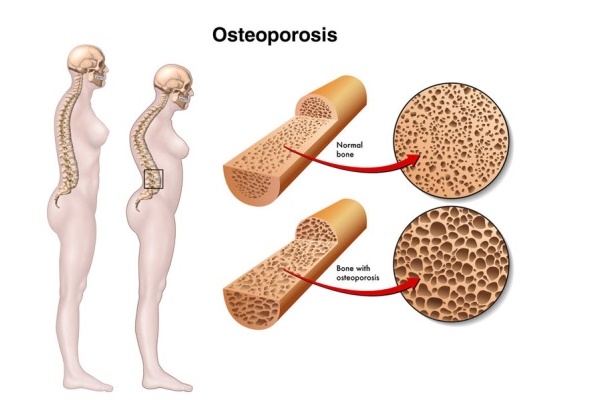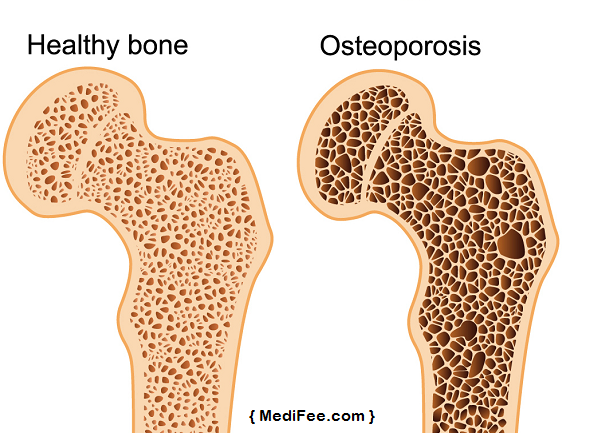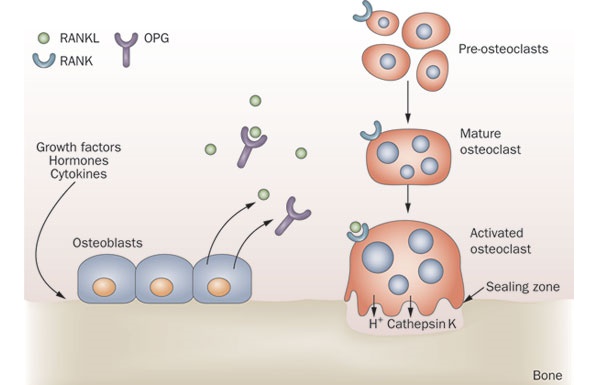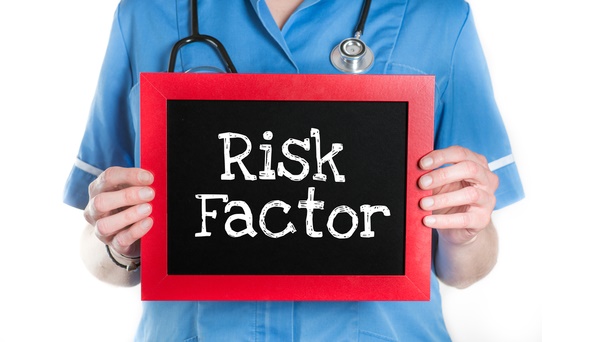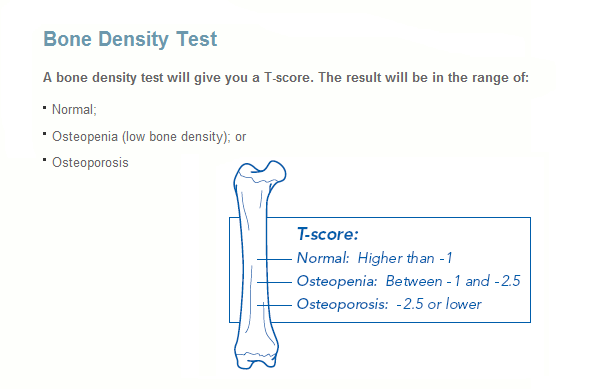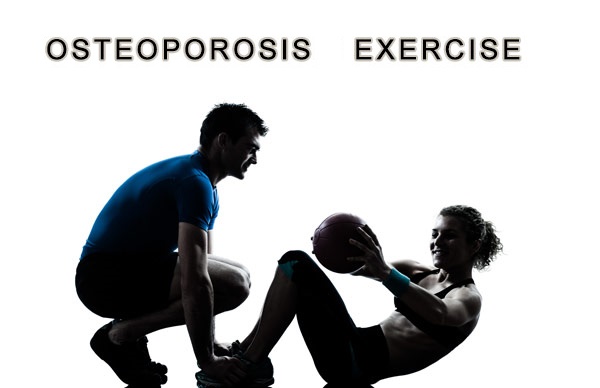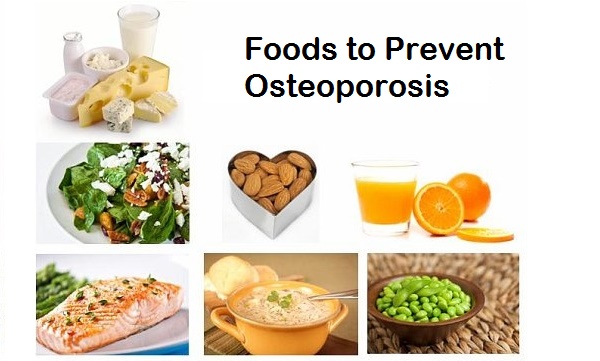Yes you read it right. Many doctors overseas, are afraid, that if osteoporosis is not taken care of at an early stage, it may lead to severe conditions. Some doctors even claim that a simple act of sneezing or coughing could lead to broken bones.
And yes, this is not something specific to the West alone. If Osteoporosis is left undiagnosed and untreated for long, anybody living in any part of the globe, can become prone to such severe medical condition.
What is Osteoporosis?
Osteoporosis means ‘porous bones.’ It is a medical condition in which bones become extensively brittle and fragile due to severe deficiency of vitamin D and calcium in body. Osteoporosis can affect any of your skeletal bones; however, hip, wrist and spines are at greater risk.
Bones are living, as they grow and continue to regenerate throughout our lives. With age, bones become weak and lose their natural capacity to regenerate. However, sufficient intake of calcium and vitamins help bones to regenerate normally.
Healthy bones, viewed under a microscope have a honeycomb like structure. However, when bones become weak, the holes in this honey comb structure expand; thus reducing the density in structure. Reduced density makes bones fragile and thus susceptible to fractures at slightest of injury or strain.
Types of Osteoporosis:
On a broader prospect, there are two types of Osteoporosis –
- Primary Osteoporosis – More than half the number of patients suffering from Osteoporosis are in true sense affected with primary osteoporosis.
- Secondary Osteoporosis – It is not very common as compared to the former type.
While the secondary has no other subdivision; primary Osteoporosis can again be divided into three sub types; namely:
- Post menopausal Osteoporosis or Type I Osteoporosis
- Involutional or Senile or Type 2 Osteoporosis
- Idiopathic Osteoporosis
Post Menopausal Osteoporosis:
A condition effecting women above the age of 45 years or so. Women reaching their menopause stop producing Estrogen for the first 5 – 8 years of menopause. The lack of estrogen in body enhances the capacity of osteoclasts, which is a multinucleate bone cell that is responsible for the absorption of bone tissue during healing.
On the other hand, Osteoblasts that produce bone tissues have nothing to enhance their cell generation capacity. Thus, with lack of estrogen, osteoclasts continue to reduce bone mass making it brittle.
Women who are having irregular menstrual cycles and thus reduced estrogen production are equally prone to this condition. Lack of testosterone in men may also lead to similar type of osteoporosis; however, the chances are quite low.
Involutional or Senile or Type 2 Osteoporosis:
A condition common with both men and women above the age of 60 years or so. Natural process of aging that is not supported with good diet and exercise make people susceptible to this type of bone disorder.
Idiopathic Osteoporosis:
Idiopathic or Juvenile osteoporosis, as the name suggests is a bone disorder affecting children. Ironically, children of age groups 8 to 14 years, show these symptoms during their prime bone development and growth years.
Secondary Osteoporosis:
Secondary osteoporosis is less common and arises due to some other illness or medication. Diseases that lead to secondary osteoporosis are:
- Diabetes Mellitus
- Hyperthyroidism
- Hyperparathyroidism
- Cushing’s disease
- Hypogonadism
Besides, there are other miscellaneous causes; such as – alcohol and cigarettes, barbiturates, anticonvulsants etc.
Osteoporosis – The Silent Disease:
One of the deadliest aspects of Osteoporosis is that it shows no symptoms of its presence; and hence known as the silent disease. It is only when you start losing your bones rapidly, you may determine the presence of this silent ailment within your body.
As women are more prone to this bone disorder, they are suggested to undergo bone investigations as one of the health screening tests by experts. Early detection can help to treat this condition, which otherwise may turn worst.
Nevertheless, osteoporosis could be determined if you are having severe back pain very frequently. Unexpected fractures with slightest injury suggest an underlying case of osteoporosis. Although very rare, a vivid symptom could be diminished height; that of course is not visible with naked eyes.
Causes of Osteoporosis – Who is at the highest risk?
There are a multitude of factors that decide if one is prone to suffer from osteoporosis at some point of time or not. Some of these parameters are not under your control; while there are many that entirely depend upon your lifestyle and related factors.
- Race: It is seen that people who are white or are of Asian descent are more likely to develop this disease.
- Gender: Women are at greater risk as compared to their male counterparts.
- Age: Aging naturally weakens your bones.
- Family History: If one of your parents is suffering from Osteoporosis, then you are at a higher risk of suffering from the same.
- Thinner body frames have reduced bone mass and thus susceptible to Osteoporosis.
- Cancer treatments may result at irregular hormonal levels and thus reduced estrogen and testosterone lead to osteoporosis as explained earlier.
- Thyroid medication and overactive thyroid gland leads to osteoporosis.
- Hyper active parathyroid and adrenal glands may lead to osteoporosis.
- Diet with low calcium, vitamin and protein concentration eventually lead to bone disorders.
- Alcohol consumption, smoking and tobacco lead to various disorders including osteoporosis.
Before you start breaking your bones – Get these lab tests done!
As already mentioned, osteoporosis does not show any vivid symptom. Only when you start breaking your bones unexpectedly, your doctor may confirm that you are suffering from osteoporosis. And that’s scary, isn’t it?
However, opting for the below mentioned test can save you your bone – if not all, may be some! Diagnosis of osteoporosis involves conventional radiography and determining the bone mineral density. Besides, additional blood tests can also be done to determine underlying causes.
Bone Density Test:
During a bone density test, a segment of hip, spine or forearm bone is tested to know the exact amount (in grams) of calcium and other minerals present in the segment. This test aims at determining how dense the bones are, and thus reveals your susceptibility to this condition before you have a broken bone.
A Bone Mineral Density score or T Score of less than or equal to 2.5 suggests osteoporosis.
DEXA (Dual Energy X Ray Absorptiometry) Scan:
DEXA (Dual Energy X Ray Absorptiometry) Scan is a popular method followed to measure the Bone density in body.
Blood marker tests and urine tests are also carried out to determine levels of protein, Vitamin D and other substances that contribute to bone health.
What to do if diagnosed with Osteoporosis?
Osteoporosis, unfortunately cannot be cured completely, but treated to prevent further bone damage. Once diagnosed with this condition, opt for these below mentioned steps to control aftermaths of osteoporosis:
- Prevent Falls:
With age, falls become more common and definitely not inevitable. However, falls can lead to severe fractures; especially in people suffering from osteoporosis. Therefore, being alert to prevent it is the best and foremost step to take.
With age, our feet get unstable. So, if you’re having such problems, talking to doctors is very essential. Besides, eye disorders such as cataract can lead to falls and thus fractures. Therefore, taking care of your eyesight is equally important.
Lastly, not straining your legs and avoiding staircases every now and then is also suggested.
In an attempt to prevent falls, many restrict their physical activities and that is wrong. Osteoporosis can be controlled only when you try maintaining your bones and prevent them from further deterioration. Therefore, slight exercises such as walking and perhaps jogging are important. You can even talk to your doctor, who can suggest you with some osteoporosis preventive exercises.
- Abstain from that pinch of salt!
Salt poses the greatest danger to our bones and the skeletal system. So, now that you have been diagnosed with osteoporosis, please do remove that salt shaker from your dining table.
Salt in general diet is still tolerable. However, those in fast food and junks are very risky and therefore needs to be avoided. Osteoporosis is directly related to our diet and nutrition. Some changes in the diet can prevent you from getting this difficult disease. Let’s know how.
Preventing Osteoporosis – Diet and Nutrition:
Osteoporosis relates to how well a lifestyle you have followed throughout your life and that precisely suggests the diet you have followed. Therefore, let’s learn what makes a good diet to prevent osteoporosis:
Vitamin D – Adults require 10 micrograms of Vitamin D each day. Therefore, including food items such as – oily fish, eggs and milk etc. provides you with sufficient vitamin D necessary for bones. Besides food, the Sun is also a great source of Vitamin D. Therefore, exposure to sun during early mornings along with healthy oil massage is recommended.
Calcium – Adults require 700mg of calcium every day. Therefore, including food items, such as – green vegetables, tofu, yoghurt, dry fruits, milk can help you achieve that level and keep your bones healthy.
Not too much of soft drinks: Soft drinks contain phosphoric acid. Phosphorous is again bad for your bones as it triggers calcium loss in body. Therefore, soft drinks, much more than the occasional ones need to be restricted. Instead, fresh orange juice, fruit smoothies and milk shakes prove beneficial.
Cut down on your caffeine intake: For every 100 milligrams of caffeine intake, you are losing 6 milligrams of calcium. So now you know how many coffee cups can get you really sick.
Soy products are debatable: Some say that soy is good for your bones while others say that inappropriate amounts can be detrimental to your bone health. Therefore, the best thing to do is to keep soy products occasional in your diet.
What else can you do?
Besides the diet you follow, there are a few other things that can prevent you from developing osteoporosis.
- Abstain from smoke, alcohol and excess salt
- Focus on exercises and physical activities. Engage in exercises right from your bone developing years.
- Opt for screening tests if you have family history of osteoporosis
- Know your medicines well as some may leave you with greater chances of developing osteoporosis
- Following correct postures is also beneficial. As for example, lifting weight with your legs and not waist is a healthy practice. However, this is not easily achievable and requires practice. Consult a therapist who can help you.
- Women who walk with longer strides are at a lower risk of osteoporosis
- Walking is more beneficial than jogging or swimming or bicycling
- Bending your knees and not hip is a good practice
Osteoporosis fractures have been known to have serious consequences. As for example, they may lead to blood clots as fractures of hip bones require months to cure and thus, restricted mobility or rather being bed ridden leads to formation of blood clots and skin sores.
Thus, taking preventive measures before hand can help you to have things under control and not allowing them to worsen and reach an irreversible state. The above discussion should help you to detect osteoporosis early and then opt for proper diagnosis and treatment measures.
Besides, following healthy diet and lifestyle right from a tender age can help you to step away from this deadly bone condition.
